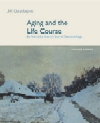1. Caregiving has become an important aspect of aging in our society. To learn
more about caregiving, read "Family Caregiving in an Aging Society"
by SusanTennstedt, Ph.D., found at the website for the Administration on Aging
(http://www.aoa.dhhs.gov/). Link to the
site index, then select the letter "c" for caregiving. After reading
the article, answer the following questions: - What percentage of Americans aged 65 and older are functionally disabled
or in need of care?
- What does the article say about gender and the amount of informal
care an elder receives?
- Why are an elder's living arrangements an important predictor of the level
of care he or she receives?
- What does Dr. Tennstedt's study say about gender and the relationship
of caregivers?
- What differences does the research show in caregiving across ethnic groups?
2. The Health Care Financing Administration (http://www.hcfa.gov)
is the federal agency that administers Medicare, Medicaid, and the State Children's
Health Insurance Program. Go to the website and link to What's New on hcfa.gov,
then to Fact Sheets. Select and read "December 14, 1999, Assuming Quality
Care for Nursing Home Residents." Answer the following questions: a. About how many elderly and disabled Americans reside in nursing homes?
Summarize the Health Care Financing Administration's instructions to states
on the enforcement of government regulations. 3. The Office of Disability, Aging, and Long-Term Care Policy (DALTCP) (http://aspe.hhs.gov/daltcp/home.htm)
is charged with developing, analyzing, evaluating and coordinating the policies
and programs of the Department of Health and Human Services that support the
independence, productivity, health, and long-term care needs of children, working
age adults and older persons with disabilities. Go to the homepage and click
on "Assisted Living for the Frail Elderly." Read the report "National
Study of Assisted Living for the Frail Elderly." Then answer the following
questions: - To what does the term"assisted living" refer?
- What is the number of assisted facilities nationwide?
- What is the major purpose of this study?
- What policy-relevant issues will be addressed in the study?
4. The Family Caregiver Alliance (http://www.caregiver.org/)
is a Web site dedicated to supporting caregivers and providing information about
diseases. Go to the site and select "Statistics" from the "Clearinghouse"
section. Click on "Who Are the Caregivers?" Then answer the following
questions: - Who is the typical caregiver, according to the California Caregiver Resource
Center?
- What is the average age of a caregiver?
- What percentage of caregivers are adult children? Spouses? Wives?
- How many hours per week does a caregiver provide care?
| 


 2002 McGraw-Hill Higher Education
2002 McGraw-Hill Higher Education